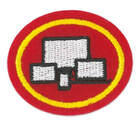|
Computers and Mobile Devices Honor Helps
Honor Requirements
| |||||||||
|
Some internal parts of a computer (from our club meeting)
Some Computer Peripherals
Cell Phone Parts from club meeting, and other Mobile Devices
Navigating a Smart Phone, and assessing usage
|
For requirement #8, obviously the history of computers is vast and complicated. Some possible approaches that may make it more manageable:
General resources for exploring the history of computers:
|
Some key individuals, Technologies, Companies, and Themes in the history of Computers
|
Themes of Exploration
Generations of computers LINK1. LINK2. LINK3. (PDF) Women in computer history LINK1. LINK2. LINK3. LINK4. Pioneers of Mechanical Computers Joseph-Marie Jacquard - punch cards and programable looms LINK1. LINK2. LINK3. Charles Babbage - ideas for Difference Engine and Analytical Engine LINK1. LINK2. LINK3. LINK4. (Video) Ada Lovelace - one of the “first” computer programers, developed algorithms, worked with Babbage and others LINK1. LINK2. LINK3. LINK4. (Video) Herman Hollerith - Tabulating machine, and predecessor of IBM LINK1. LINK2. LINK3. LINK4. LINK5. Pioneers of Early Electronic Computers and Facilitating Technologies Dr. John Ambrose Fleming - Diode Vacuum Tube (oscillation valve) LINK1. LINK2. LINK3. Lee De Forest - Triode Vacuum Tube (audion tube) LINK1. LINK2. LINK3. George Stibitz - Bell Labs - boolean logic circuits and digital computer LINK1. LINK2. LINK3. LINK4. John Vincent Atanasoff - ABC - first electronic digital computer LINK1. LINK2. LINK3. LINK4. John Mauchly and J. Presper Eckert - ENIAC and UNIVAC - first electronic digital computer Mauchly: LINK1. LINK2. LINK3. (Interview) Eckert: LINK1. Mauchly and Eckert: LINK1. LINK2. ENIAC: LINK1. LINK2. LINK3. UNIVAC: LINK1. LINK2. LINK3. Sir Freddie Williams, Tom Kilburn, and Geoff Tootill - Manchester Baby/SSEM, first digital electronic program stored and run on a computer. Williams: LINK1 Kilburn: LINK1. LINK2. Tootill: LINK1. LINK2. (interview) Manchester Baby: LINK1. LINK2. LINK3. Calvin Mooers - information retrieval theory and Moores Law LINK1. LINK2. LINK3. (PDF) William Higinbotham - Tennis for Two (possibly first video game) LINK1. LINK2. |
Pioneers of Technologies of Modern Computers and Mobile Devices
Christopher Lathan Sholes, Samuel W. Soule, Carlos S. Clidden - QWERTY keyboard on Sholes and Glidden Typewriter LINK1. LINK2. LINK3. LINK4. LINK5. LINK6. LINK7. Douglas Engelbart - The Mouse LINK1. LINK2. LINK3. William Shockley, John Bardeen, and Walter Brattain - The Transistor Shockley: LINK1 Bardeen: LINK1 Brattain: LINK1 Transistor: LINK1. LINK2. Jack Kilby and Robert Noyce (Co-founder of Intel). - Microchip (TI and Fairchild) Kilby: LINK1. LINK2. Noyce: LINK1. LINK2. Microchip: LINK1. LINK2. Federico Faggin, Marcian (Ted) Hoff, Stanley Mazor, and Masatoshi Shima - Intel’s 4004 Microprocessor chip Faggin: LINK1. LINK2. Hoff: LINK1. LINK2. LINK3. Mazor: LINK1. LINK2. Shima: LINK1. LINK2. (interview transcript) Microprocessor: LINK1. LINK2. LINK3. Robert H. Dennard - DRAM LINK1. LINK2. LINK3. Henry Edward “Ed” Roberts - Altair 8800 LINK1. LINK2. LINK3. Adam Osborne - Osborne 1 - first marketable portable computer LINK1. LINK2. LINK3. William Hewlett and David Packard - Co-founders of Hewlett Packard Hewlett: LINK1. LINK2. Packard: LINK1. LINK2. HP: LINK1. LINK2. Steve Jobs and Steve Wozniak - Co-founders of Apple Jobs: LINK1. LINK2. Wozniak: LINK1. LINK2. Apple: LINK1. LINK2. (timeline) Bill Gates - Co-founder of Microsoft LINK1. LINK2. LINK3. LINK4. Linus Torvalds - LINUX and open source code LINK1. LINK2. LINK3. (interview) Robert Elliot Kahn, Vincent Cerf - TCP/IP Khan: LINK1. LINK2. Cerf: LINK1. LINK2. TCP/IP: LINK1. LINK2. Sir Timothy John Berners-Lee - “inventor” of the Internet LINK1. LINK2. LINK3. Martin "Marty" Cooper - first handheld portable cellular phone LINK1. LINK2. LINK3. |
